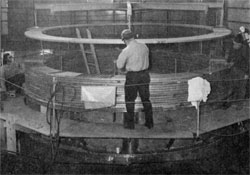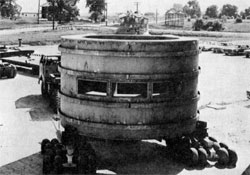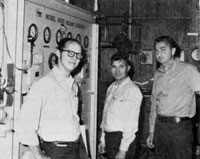Magnet Test Completed Successfully
Early on the morning of Monday, October 10, 1972, the superconducting magnet that is an integral component of the NAL 15-foot Bubble Chamber, finished its first test run with complete success. The magnet reached its full design parameter - 30 kilogauss central field (about fifty thousand times the earth's magnetic field) - about 5 a.m. after men and machine had been tested with equal intensity for several weeks. Filling of the magnet with liquid helium was completed on Sunday, October 8, and once full of liquid, the magnet was energized and progress was rapid.
The 150-ton magnet surrounds the 15 ft. Bubble Chamber. Its purpose is to act on particles that come from the Main Ring into the chamber by bending the track of the particles so that one may be distinguished from another in the photographs that are taken from the top of the chamber. The high energies obtained with the NAL accelerator mean that the particles are traveling at very high speeds. The magnetic field must be large enough to bend these speeding particles. This magnet is one of the most powerful and most advanced in the world today.
The physical parts of the magnet are fully enclosed in a container filled with liquid helium. The testing that had been underway since September 6 involved first cooling the magnet, about one degree per hour, down to close to absolute zero (-452.1 degrees F) to achieve the physical effect known as superconductivity in which materials at this low temperature lose resistance to the flow of electricity. In conventional electromagnets, heat is produced because of the resistivity of the current-carrying conductor. Considerable power is used in producing this heat, and that power is simply wasted. Since there is no resistance to current flow in a superconducting magnet, no heat is produced and therefore no power is lost. A relatively small source of electrical power is needed to charge the magnet and electric power is used primarily to keep the refrigeration operating. The saving in power cost over the long run will be substantial.
To take advantage of the expertise accumulated at the Argonne National Laboratory during the construction of Argonne's 12-foot bubble chamber several years ago, and to minimize the burden on the staff at NAL for constructing the 15-foot chamber here, the decision was made to have Argonne build the magnet for NAL. This joint effort between ANL and NAL proved to be very satisfactory. During the two-year span of the project, ANL and NAL staff worked side by side toward successful completion. The project finished within budget estimates, and the cooperation enabled NAL staff to learn of the machine as it was built and to be ready for operating when it was finished. Argonne personnel who worked on the project included John Purcell, Henri DesPortes (visiting scientist from Saclay), Tom Cameron, Karl Mataya, Bruce Millar, and Dick Jones (deceased).
John Purcell spoke of the successful test run by saying, "After going through the tests of the ANL 12-foot bubble chamber magnet, this test was more like a routine run than a test. I would like to thank the NAL operating crews for helping make this the smoothest test in big magnet history."
Members of the NAL Bubble Chamber staff working on shifts during the cooldown were: R. Ahlman, George Athanasiou, F. Bellinger, D. Curtice, R. Davis, J. Fogelsong, H. Kautzky, J. Kilmer, Mike Morgan. George Mulholland, R. Niemann, W Noe, J. Stoffel, J. Thompson, and J. White.
Also contributing to the magnet construction efforts were: Steve Johnson. George Simon, Paul Thorkelson, David Oprondek. Hoyt Smith, Art Skraboly, Lee Mapalo, George Nosal, Harry Stapay. William Fowler headed up the Bubble Chamber work at NAL, assisted by Russell Huson.
NAL 30" Bubble Chamber personnel who lent their assistance to the project included: Dick Brazzale, Jim Harder, Gary Hodge, P.P. Keefer, George Powell, Vance Sauter, Fred Walters and Del Q. Wilslef.
Hans Kautzky, one of the NAL people most intimately concerned with the construction, described the main components of the huge magnet: An upper and lower coil stack each consisting of more than twenty "pancakes." A "pancake" has three layers - spiral wound from a stainless steel strip for strength, then a mylar strip for insulation, and then a copper strip embedded with superconducting strands (60 strands, each only 15/1000 inch thick) conducting all current (5,000 amps.). The pancakes are stacked, then joined by soldering. The vacuum-tight helium can surrounds this stack. Only two small openings - one for cooling equipment and one for power leads - can be found on top. Layer after layer of super-insulation surrounds the can, up to an outer stainless steel skin which is welded all around. Precise, accurate workmanship was necessary at every step because, once closed, the magnet is a completely-sealed unit and none of the components can be reached. Main technical parameters of the magnet are: Field in center: 30 kilogauss. Bore diameter: 14 feet; height 10 feet. Stored energy: 400 megajoules.
George Mulholland who was in charge of operations during the test, viewed the achievement as follows: "The magnet and its cryogenic system grew out of a marriage of national laboratories, industry, and consulting firms. The totally successful nature of the first test was a credit to all those involved and particularly satisfying to those of us who get to move on to the next Bubble Chamber challenge."
"Essential to the whole effort were the Controls Group under Bob Daniels, and the Alignment Group under Bill Testin. Tom Pawlak was the DUSAF representative."
He continued, "Miguel Awschalom and his stalwart staff kept us always honest radiation-wise, and, finally, Ginny Linguist has kept typing typed and the coffee warm."







